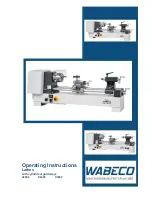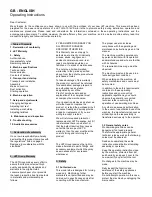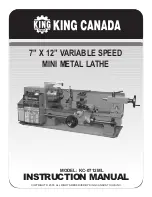
31
6.
Check for crooked stock (this can result in straight,
but not square cuts).
7.
Left saw guide arm is loose, or not positioned close
enough to the stock being cut.
8.
Saw band pitch choice is incorrect.
9.
Check for incorrect saw band tension.
10.
Check for incorrect adjustment of inserts, back-up
bearing, or worn pivot bolts.
11.
Check machine alignment. Have a DoALL Industrial
Supply Center service representative check and/or
adjust machine alignment.
12.
Check for coolant not being supplied evenly to both
sides of the saw band.
SURFACE FINISH OF CUT-OFF PIECE IS
TOO ROUGH
1.
Check for vibration while sawing.
2.
Check for a damaged saw band.
3.
Use a finer pitch saw band.
4.
Increase band speed being used and/or decrease
the feed rate or feed force.
5.
Check the saw band back-up guides for wear. Re-
place them if necessary.
6.
Check for incorrect saw band tension.
CUTTING RATE IS TOO SLOW
1.
Use a coarser pitch saw band.
2.
Increase band speed and/or feed rate/feed force.
STOCK FEEDS ERRATICALLY
1.
Check for low hydraulic system oil level.
2.
Check for damaged or faulty index feed cylinder.
INDEX VISE WON’T MOVE FORWARD
1.
Check to see if
Solenod
is energized.
2.
Hydraulics must be "on" and in "manual" mode.
3.
One of the vises must be open.
VISES WON’T TRANSFER AFTER AN INDEX
1.
Check for faulty operation of the index forward
proximity switch
( PRS)
on the index vise base.
2.
Check for faulty operation of
Solenods 7 and 8.
INDEX WON’T RETURN
1.
Check fo see if
Solenod 3
is energized.
2.
Check for incorrect adjustment of the index forward
proximity switch
( PRS)
.
VISES WON’T TRANSFER & SAW HEAD
STAYS DOWN
1.
Check for faulty operation of the head down proxim-
ity switch
(5 PRS)
.
2.
Check to see if
Solenod 1
is energized.
SAW HEAD WON’T LOWER
1.
Vises must be clamped.
2.
Hydraulics must be "on" and in "manual" mode.
3.
The feed rate setting is too low.
4.
Check the head-clear proximity switch
(3 PRS)
for
faulty operation.
5.
Check
Solenods 1 and 10
for incorrect opera-
tion.
6.
Check for saw head obstruction.
SAW HEAD WON’T RAISE, OR RAISES
SLOWLY
1.
Check for faulty
Solenod 1
operation.
2.
Check for low hydraulic system pressure caused
by blockage, clogged oil filter cartridge, or pinched
hose.
SAW HEAD LOWERS ERRATICALLY
1.
Bleed air from the head lift cylinder. It may be neces-
sary to raise and lower the saw head several times
to thoroughly bleed the head lift cylinder.
TROUBLE SHOOTING (Continued....)
Summary of Contents for DC-330NC
Page 1: ......
Page 5: ...MACHINE DIMENSIONS FLOOR PLAN INCHES 03 MILLIMETERS 1 mm...
Page 6: ...MACHINE DIMENSIONS Continued INCHES 03 MILLIMETERS 1 mm FRONT VIEW...
Page 7: ...MACHINE DIMENSIONS Continued INCHES 03 MILLIMETERS 1 mm SIDE VIEW...
Page 8: ...MACHINE FEATURES FRONT VIEW...
Page 9: ...MACHINE DIMENSIONS Continued REAR VIEW...
Page 10: ...MACHINE DIMENSIONS Continued PROXIMITY LIMIT SWITCH LOCATIONS TOP VIEW...
Page 27: ...23 LUBRICATION NEXT 2 PAGES...




























